

AI Sales Enablement: The Complete Guide to Smarter Coaching, Content, and Conversions

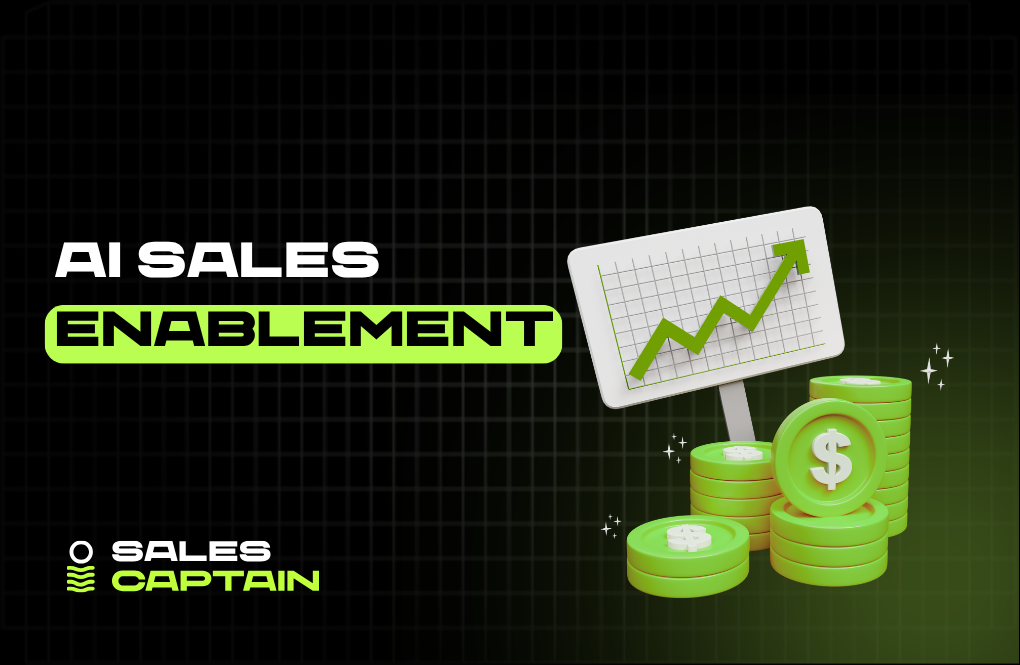
What is AI Sales Enablement?
Definition and core concepts
AI sales enablement is the application of artificial intelligence, specifically machine learning, large language models, and real-time data processing, to optimize how sales teams access knowledge, coaching, content, and buyer insights. It's not just tech layered onto enablement. It’s a new operating system.
Instead of reps manually digging for materials or winging messaging, AI systems surface exactly what’s needed in the moment. Instead of managers doing 1:1 call reviews, AI breaks down patterns across entire teams and offers instant feedback. Every part of enablement, content delivery, onboarding, coaching, call prep, and follow-up gets sharper, faster, and more personalized.
At its core, AI sales enablement is about scale. Scaling guidance. Scaling expertise. Scaling execution.
How it differs from traditional sales enablement
Traditional sales enablement is slow. Loads of PDFs. Long onboarding. Random Slack pings asking, “Where’s that deck?” Reps waste hours hunting for the right assets or hoping a manager has time for feedback. Strategy is often gut-led, not data-driven.
AI flips the script. Content is indexed and recommended dynamically based on context. Reps get in-call coaching, not just reviews after the fact. Insights are continuous, not quarterly. The entire system becomes adaptive. Fast learners move faster. New reps ramp sooner. Top performers scale their workflows across teams.
Bottom line: traditional enablement depends on humans remembering, sharing, and coaching. AI enablement builds systems that do it automatically, so humans can focus on selling.
The role of generative AI and machine learning
Generative AI and machine learning are what make AI sales enablement feel more like a living system than a static process. ML identifies patterns across rep behavior, buyer engagement, and deal progression. It helps flag what's working, what’s not, and who needs support, before it becomes a lost deal.
Generative AI takes it further. It writes outreach. Draft follow-ups. Summarizes calls. Even builds training materials based on how top reps speak and present. It turns tribal knowledge into shareable assets. It gives every rep the playbook of your best seller, and then personalizes it to the buyer in front of them.
These aren’t just smarter tools. They’re co-pilots that shift enablement from reactive cleanup to proactive acceleration.
Key Benefits of AI in Sales Enablement

Increased productivity and efficiency
AI chops hours off sales cycles by eliminating repetitive tasks. No more hunting for the right template. No more juggling tabs mid-demo. With context-aware suggestions, real-time guidance, and automatic follow-ups, reps spend more time selling and less time clicking around.
Instead of adding more tools, AI makes your existing stack work better. It stitches workflows together and removes friction everywhere. Efficiency isn’t just a side effect, it’s the whole point.
Enhanced sales coaching and training
Old-school sales coaching depends on managers listening to calls (if they have time), spotting issues (if they catch them), and delivering feedback (hopefully at the right moment). AI fixes the timing gap.
By analyzing every call, email, and meeting, AI identifies coaching opportunities the moment they happen. It flags objection-handling gaps, talk-to-listen ratios, missed cues, and ramps up personalized feedback for each rep. You get scalable, targeted coaching without bottlenecking on a single manager’s calendar.
Faster content discovery and personalization
Too much sales content rests in cloud drives. AI brings it to life. Reps get the right collateral, case studies, or messaging snippets surfaced automatically, matched to buyer stage, persona, or industry. It’s not just about “having” content. It’s about using it at the perfect moment.
Some systems even tailor the content before it's sent, dynamically customizing messaging without extra work. Personalization stops being manual. It becomes ssystematized
Improved lead scoring and prioritization
Lead scoring used to be a one-size-fits-all model, with basic firmographics, job titles, and page views. AI enriches leads with real-time engagement data, then uses ML to prioritize based on intent, timing, and fit.
This creates sharper workflows and clearer priorities. Reps know where to focus and when. Pipeline quality goes up. Churned effort goes down.
Real-time support during sales calls
AI listens in. Not to spy, but to assist. It surfaces relevant talk-tracks, content links, case studies, and competitor insights in the moment, based on what the buyer is saying right now.
Instead of flipping tabs or stalling mid-call, reps stay in flow and still handle complexity like a pro. This isn’t a call recording. It’s smart in-call augmentation.
Better alignment between sales and marketing teams
AI removes guesswork from the sales-marketing handoff. It tracks which assets are used, which messaging converts, and where content falls flat. Marketing gets real-time feedback on what works. Sales gets materials fine-tuned to buyer signals.
Everyone sees the same data. Campaigns move faster. Messaging tightens. Silos shrink.
Data-driven decision-making and forecasting
Gut feeling doesn't scale. AI enables forecasting that holds up, built on rep activity, buyer engagement trends, and deal patterns that humans can’t track on their own.
It also helps GTM ops teams iterate faster. Instead of running blind, they build feedback loops powered by real-time insights, not lagging indicators.
Top Use Cases and Capabilities
Automated and personalized content creation
Reps waste time rewriting the same emails or customizing assets from scratch. AI handles it at scale. It pulls in context, writes intros, tailors messaging, and keeps voice and tone aligned.
That includes more than emails, think proposal decks, tldr summaries, even competitor compares on the fly.
AI-powered content recommendations
AI tracks what buyers are engaging with, where deals are in the funnel, and which assets move them forward.
It then suggests the next-best content automatically. Whether you're prepping for a call or replying to a DM, the right enablement asset is ready. Not buried in Notion.
In-the-flow sales coaching and feedback
Coaching shouldn't wait for 1:1s. AI gives reps immediate post-call insights, what went well, what needs work, and how to improve. Some platforms offer feedback moments after the call ends.
This tightens the learning loop and makes coaching continuous, not episodic.
Real-time conversational guidance
During live calls, AI pops up relevant prompts, objection-handling cues, or competitive angles, based on buyer statements in real time. It’s like having your top AE whispering in your ear during every pitch.
No mental juggling. Just better conversations, start to finish.
Smart lead tracking, segmentation, and scoring
AI syncs deal data, enriches contacts, tracks engagement across channels, and flags signals humans would miss, like pages viewed, reply sentiment, or ICP matches.
Then it assigns smart scores that evolve as deals progress. Segments get sharper. Outreach gets smarter.
Forecasting sales outcomes with predictive analytics
Who’s likely to close? Which deals are stalling? Where’s risk hiding? Predictive models built on behavioral and conversational signals answer those questions early, before end-of-quarter panic hits.
That means cleaner forecasts and clearer action plans.
Personalized onboarding experiences
One-size-fits-all onboarding wastes time. AI builds rep-specific learning paths based on role, learning gaps, and strengths. Live call data and ramp metrics shape the program in real time.
This leads to faster time-to-first-close and stronger early confidence.
Role-based enablement and playbooks generation
AI generates role-specific playbooks based on best performers, what they say, show, send, and sequence. Whether it's an AE, BDR, or CSM, every individual sees what's working for their exact motion.
It's not just docs. It's an executable strategy, surfaced dynamically.
Turning tribal knowledge into team-wide assets
Every org has informal experts. The top 5% who always know what to say and when. AI captures their patterns, talk tracks, collateral use, objection handling, and translates them into repeatable workflows others can follow.
That's how top performance scales.
How AI Solves Common Sales Enablement Challenges
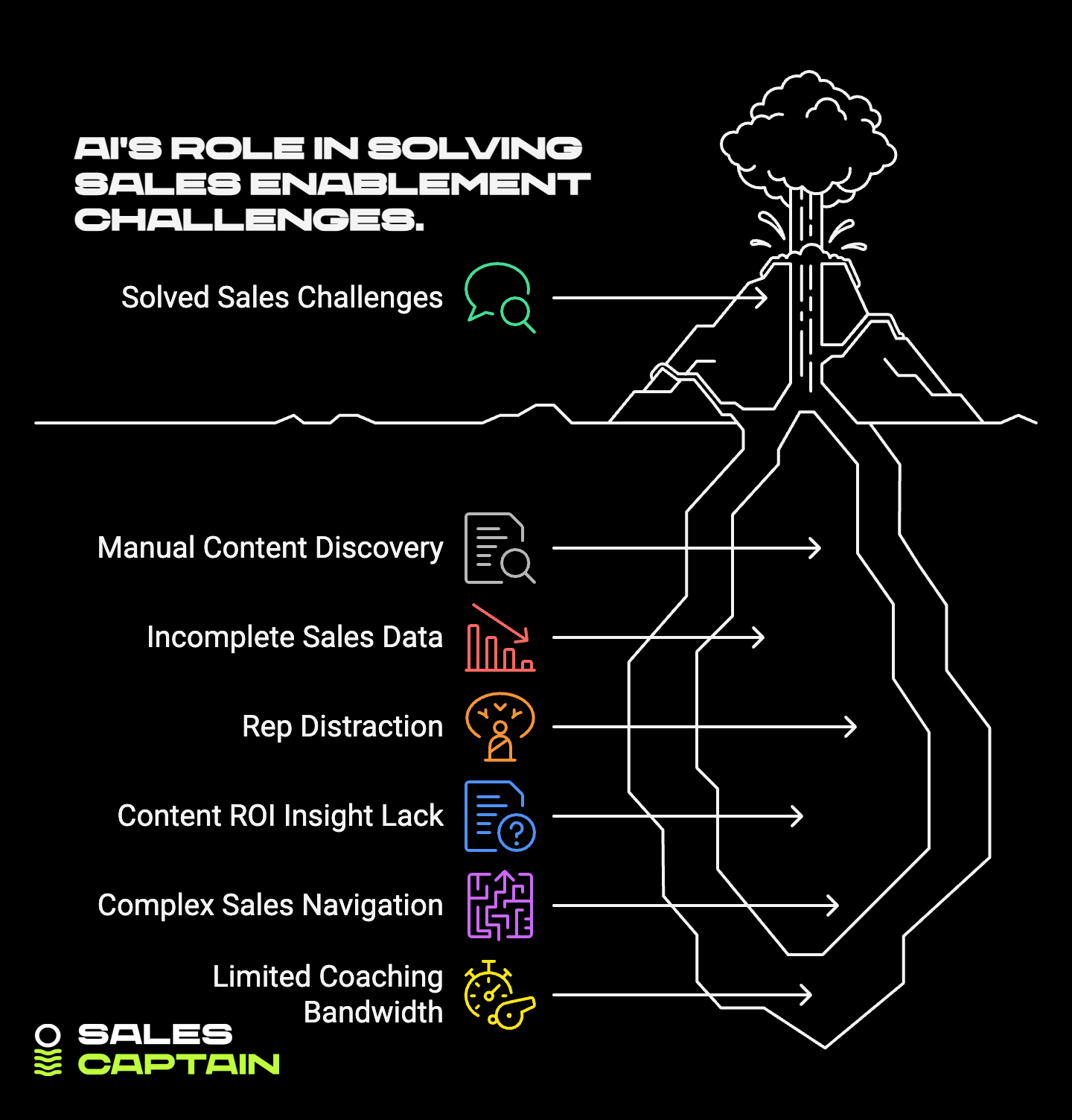
Manual content discovery and management
Reps shouldn't have to dig through folders or ask on Slack for content. AI indexes and tags every asset, then recommends the right one based on persona, use case, and stage.
Sales enablement content goes from “somewhere out there” to “right here, now.”
Missing or incomplete sales data
Manually logging everything into the CRM is a fantasy. Reps don’t do it, and when they do, it’s inconsistent. AI fills the gaps by capturing call data, emails, meeting notes, and buyer interactions automatically.
The result? Cleaner data, tighter reporting, and better outcomes across the funnel.
Reps distracted during calls by searching for info
AI turns frantic tab-switching into seamless workflows. It listens in real time and surfaces resources as needed, collateral, competitive intelligence, and objection primers, without the rep lifting a finger.
Reps stay present. Buyers feel heard. Deals close faster.
Lack of insight into content impact and ROI
Most enablement teams can’t prove which decks or PDFs help close. AI tracks usage, attribution, and buyer engagement across assets, connecting the dots between content and revenue.
That means smarter content creation and more strategic GTM inputs.
Navigating complex enterprise sales
Enterprise deals are messy. Multiple buyers, long cycles, competing vendors. AI maps deal engagement across stakeholders, flags gaps, recommends strategies, and tracks internal influence networks.
It’s not just “deal support.” It’s situational awareness at scale.
Limited bandwidth for manager-led coaching
No manager can coach every call or every rep. AI listens to them all. It scores every call, extracts themes, and surfaces coaching opportunities automatically.
Managers focus their time where it matters. Reps don’t wait weeks for feedback.
Core Components of an AI-Enabled Sales Enablement Tech Stack
Conversation intelligence tools
These tools record, transcribe, and analyze sales calls, surfacing insights like talk ratios, keyword usage, objection patterns, and buying signals. They underpin real-time coaching, trend-spotting, and rep development.
Think of them as your always-on call analyst.
Content management and activation platforms
Forget drive folders and random share links. These platforms help store, organize, tag, and personalize sales collateral, then deliver it contextually through AI.
AI-powered platforms surface the right asset, in the moment, directly where reps work.
Sales readiness and training platforms
Training shouldn’t just be videos and tests. The right platforms use AI to build adaptive learning plans, simulate conversations, and track competency on core topics dynamically.
They help onboard faster and upskill continuously.
CRM and sales analytics integrations
CRMs are only as useful as the data inside. AI-powered integrations sync conversations, pull in unstructured notes, and enrich records in near real time. That unlocks better forecasting, cleaner dashboards, and stronger handoffs.
It also closes the dreaded “rep didn’t log it” gap without nagging.
Real-time coaching and knowledge assistants
These are your in-the-moment enablement layers. They listen to calls or monitor inboxes, popping up insights, snippets, and playbook suggestions as reps work.
The goal? Less memory. More action. Better timing.
Data orchestration and workflow tooling
AI can’t work without a signal. Data orchestration tools pull together behavioral, firmographic, and conversational data so the rest of the GTM system can run cleanly. When combined with no-code workflow builders, they unlock GTM's agility.
This is where technical operators shine. GTM becomes a programmable system, not just a collection of tools.
Best AI-Powered Sales Enablement Tools
Gong
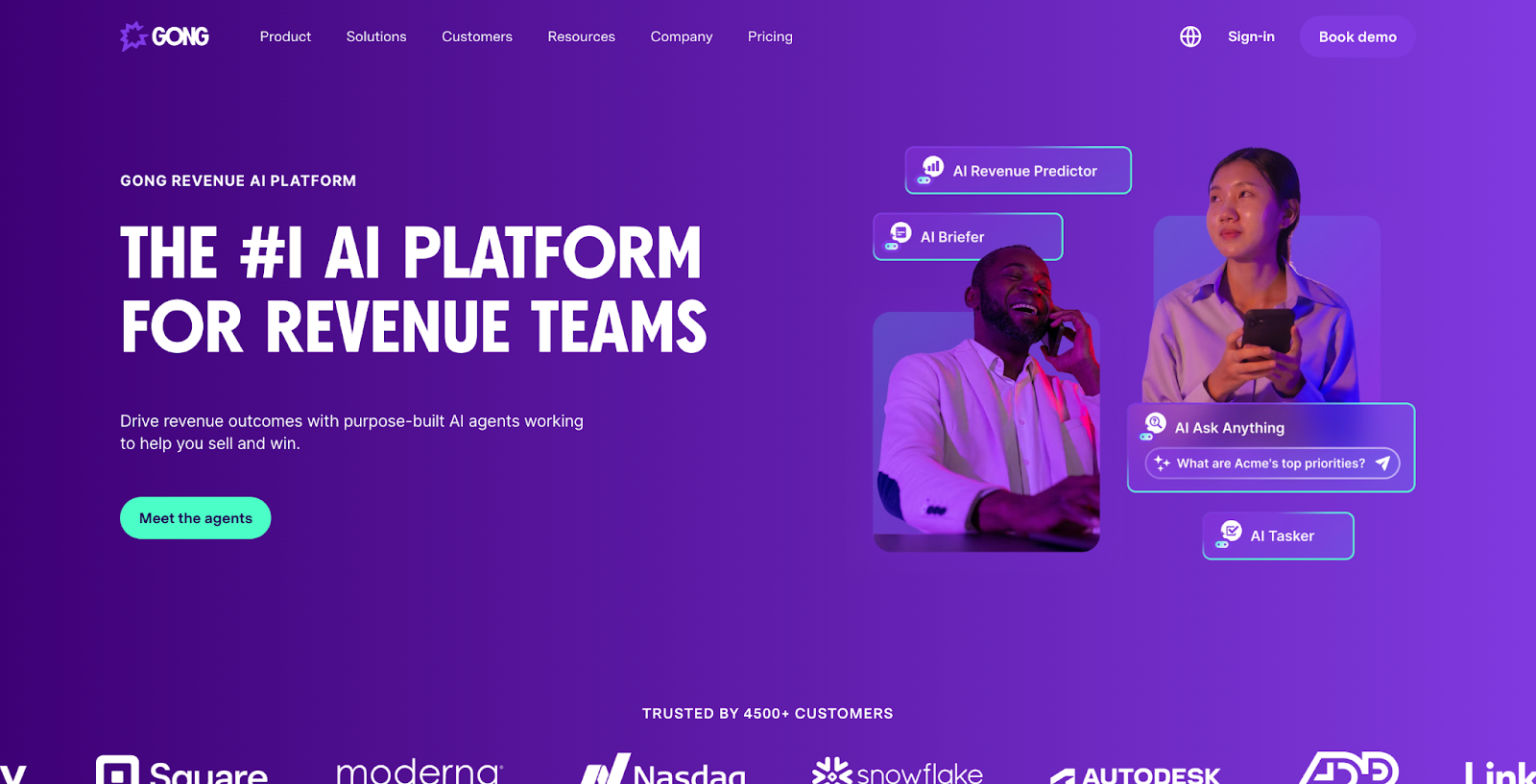
Gong doesn’t just record sales calls; it turns every conversation into actionable intelligence. Using AI to track talk patterns, objection handling, deal risks, and next steps, Gong gives reps and managers a crystal-clear view into what’s happening in the pipeline. Need to know why deals are stalling? Gong knows. Want to scale what top sellers do? Gong highlights the exact words, sequences, and insights that work.
It’s especially powerful for coaching. Instead of random call reviews, managers get heatmaps showing which reps need help and where. Plus, with deal boards and pipeline views powered by real buyer behavior (not just rep updates), forecast accuracy gets a serious upgrade.
Mindtickle
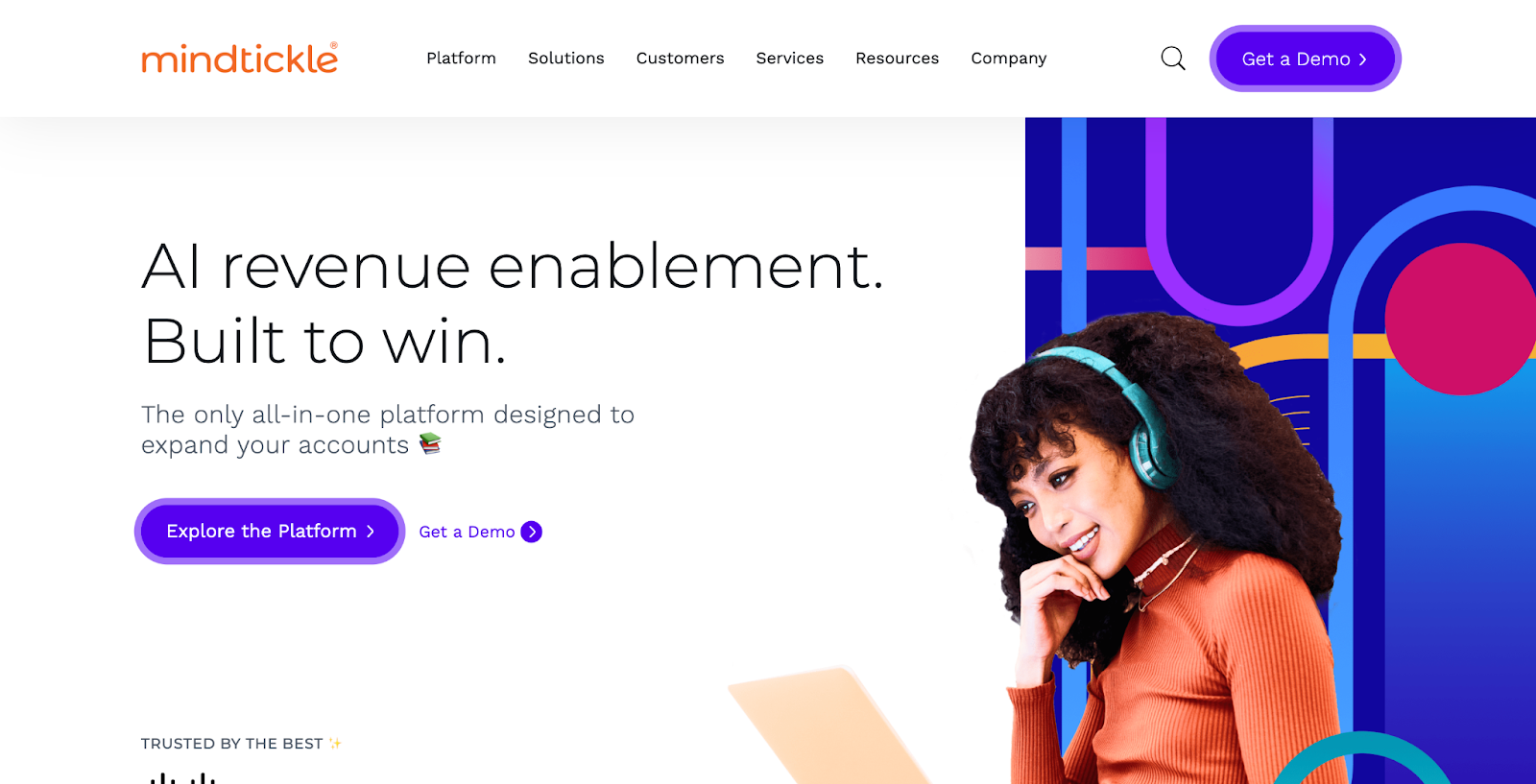
Where Gong listens, Mindtickle trains. Its AI overlays are built for skill development, measuring rep readiness, identifying competency gaps, and adapting learning journeys based on real performance data. Think quizzes, simulations, peer comparisons, and call breakdowns, all personalized.
It’s not just onboarding. Mindtickle keeps reps sharp across product updates, messaging pivots, and competitive shifts. And the AI doesn’t just test for knowledge, it tracks behavior and results to close the loop between training and performance.
Highspot
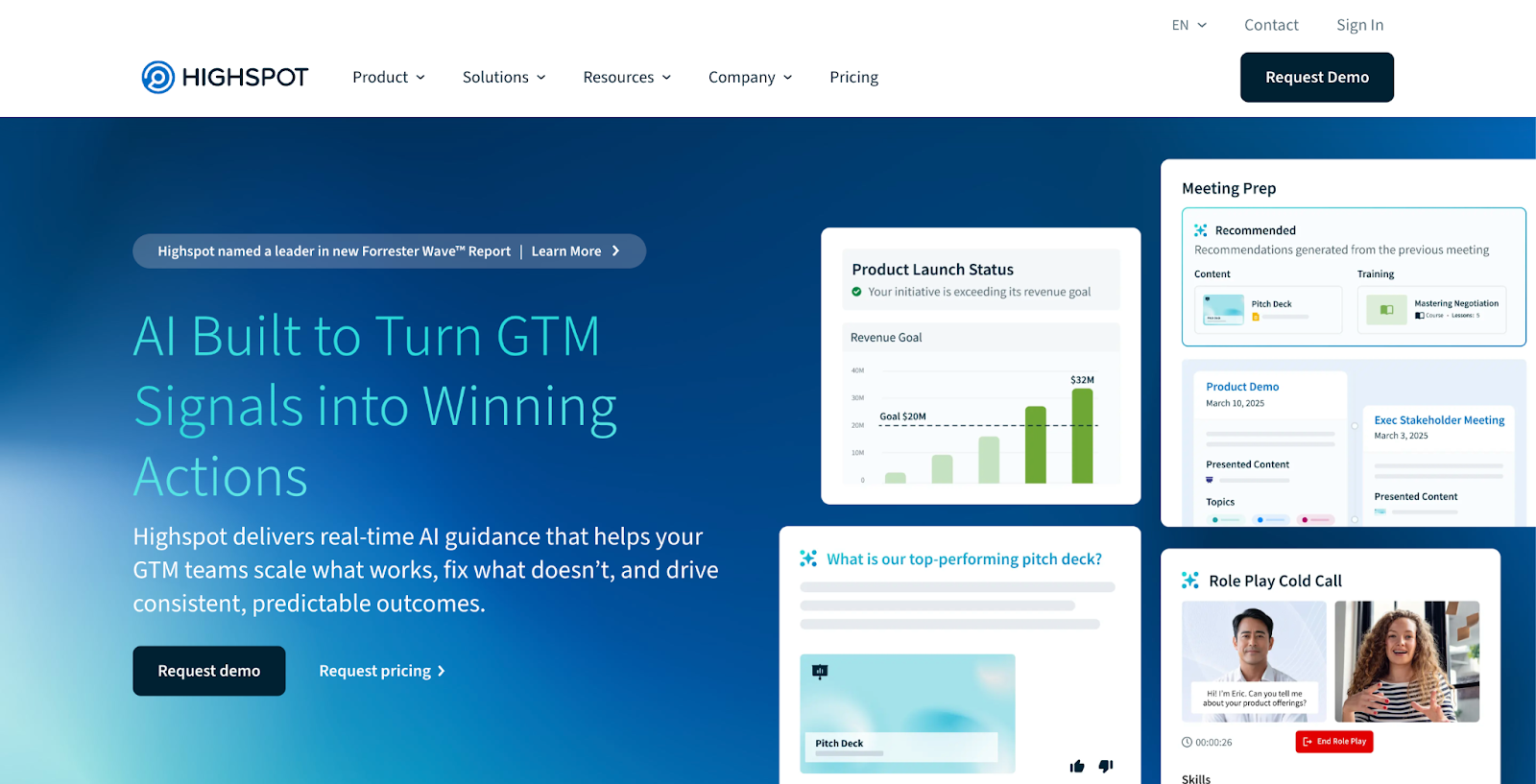
Highspot is where content meets enablement. It catalogs every asset, decks, PDFs, snippets, playbooks, and uses AI to recommend what to use, when, and with whom. So reps stop guessing and start sending the materials that influence buyer behavior.
What makes Highspot stand out is its activation layer. It doesn’t just store content, it tracks engagement and impact. You’ll know which collaterals drive pipeline and which ones rot in inboxes. Marketing loves the insights. Sales loves the time saved.
Spekit
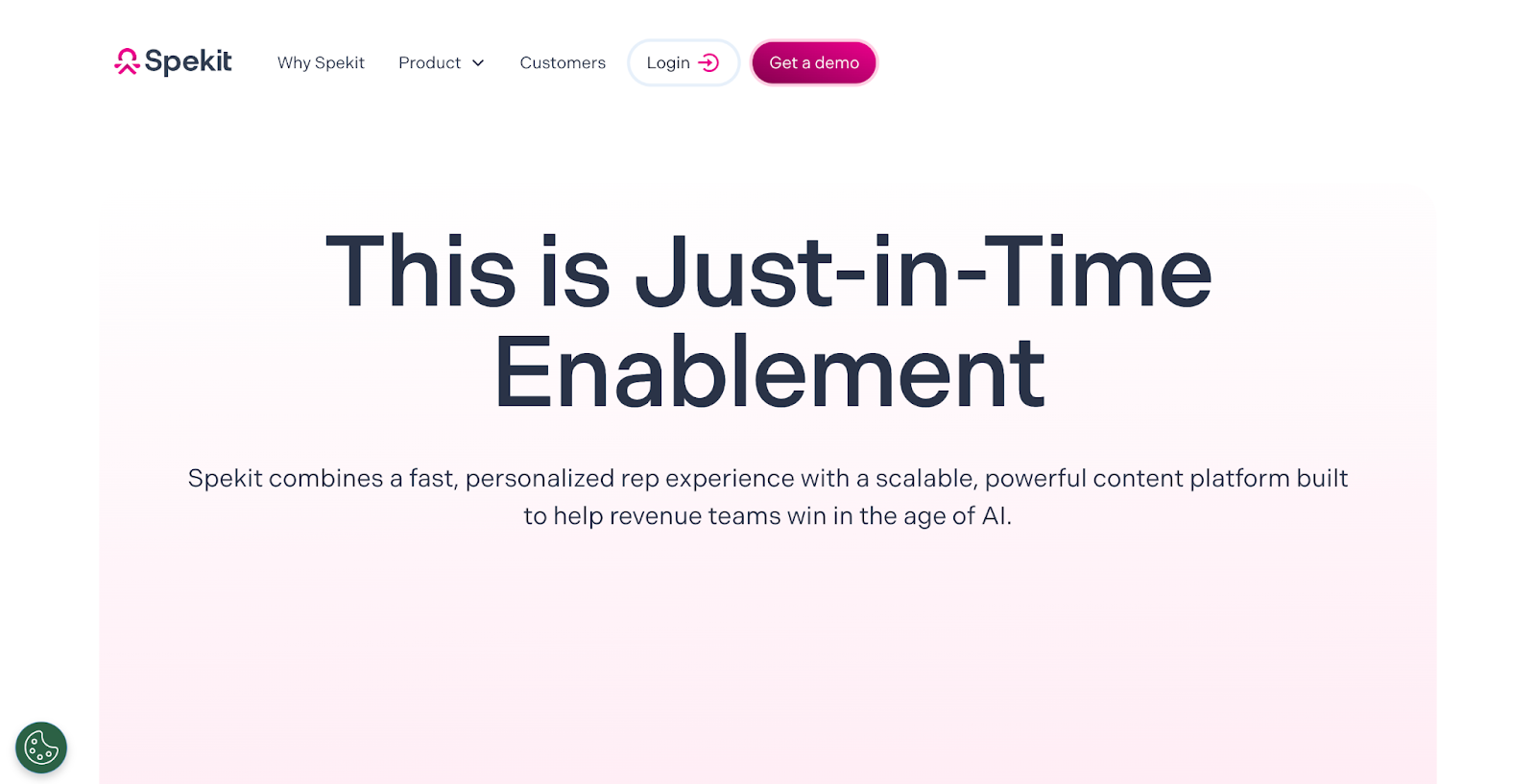
Spekit is enablement inside your workflow. It brings bite-sized guidance directly into tools reps already use, CRMs, emails, and dialers. Think tooltips, pop-ups, embedded training, all triggered contextually based on what the rep is doing.
AI powers smart nudges. About to log the wrong deal stage? Spekit steps in with the right guidance. Using outdated messaging? It shows the latest. It’s like having an enablement lead whispering in your interface, 24/7.
Drift
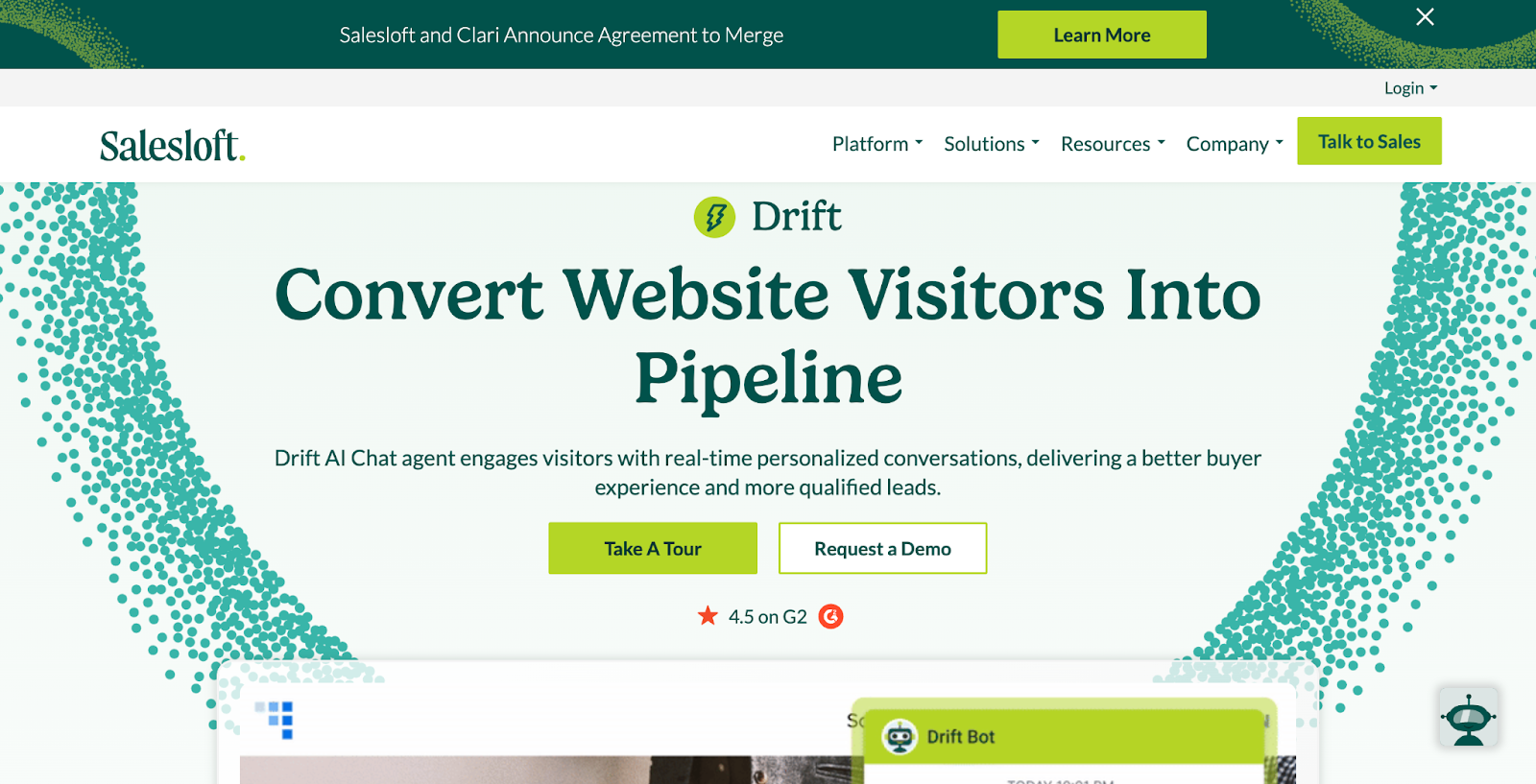
Originally a chatbot, Drift’s evolved into a full-on buyer engagement AI layer. It's real-time chat, email assistant, and routing intelligence connect prospects instantly with the right info or team, based on context and behavior.
In the enablement space, Drift helps reps respond faster, personalize better, and keep conversations warm while they sleep. It automates follow-ups, surfaces relevant content mid-thread, and uses AI intent signals to prioritize high-fit buyers. For outbound teams pushing speed and volume, Drift gives your outreach operational stamina.
Salesforce Einstein
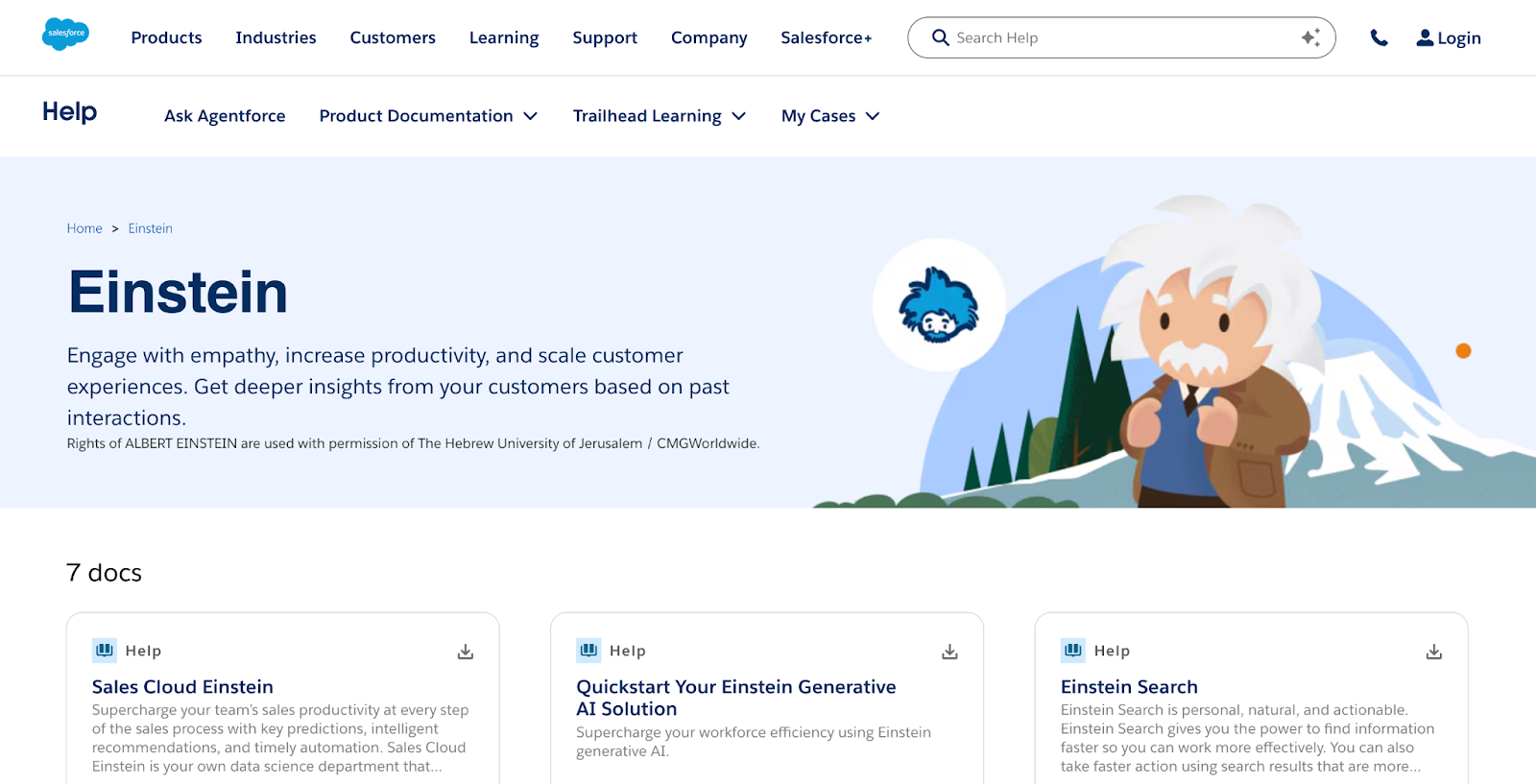
Einstein isn’t a standalone tool; it’s an AI engine built into Salesforce that makes all your CRM data smarter. On the enablement front, it predicts deal outcomes, recommends next actions, scores leads, and automates tasks that typically eat sales time.
Think opportunity insights, dynamic playbooks, and automated alerts when deals veer off-track. Einstein turns your CRM from a graveyard into a living strategy hub. And because it hooks into everything already running on Salesforce, it’s installed across workflows by default, not just another tab to open.
Other notable platforms and emerging tools
AI sales tech is exploding, and while the top players get most of the spotlight, some rising stars push boundaries in powerful ways:
- Lavender uses AI to coach email writing in real time. Perfect for SDR teams trying to improve personalization without killing scale.
- Regie.ai builds outbound sequences in minutes, tailoring them by persona and tone.
- Attention surfaces real-time cues during live sales calls, helping reps respond faster and smarter.
- Momentum turns Slack into a deal command center by pulling in Salesforce, notes, and tasks automatically.
This is where technical operators thrive. Most of these tools don’t just plug in; they require clean data, smart workflows, and thoughtful orchestration to really shine. That’s also why many growth orgs bring in support from demand gen or cold outreach agencies like SalesCaptain to accelerate setup, integration, and go-to-market planning.
Framework for Implementing AI in Sales Enablement
Step-by-step guide for phased implementation
Phase 1: Assessment & foundation
Before touching a tool, map the current state. Where are reps losing time? What onboarding gaps keep showing up? Is content discoverable? Is call coaching scalable? Most teams have pain; they just haven’t measured it.
Use this phase to set goals, collect feedback from reps and managers, and audit your tech stack. You’ll need clean CRM data, defined personas, clear sequences, and aligned KPIs to build on. Without strong foundations, AI will amplify chaos instead of progress.
Phase 2: Tool selection & integration
Now comes the stack. Don’t chase features. Work backwards from use cases.
Need better onboarding? Prioritize platforms like Mindtickle or Spekit. Close coaching gaps? Look at Gong. Want smarter outbound? Explore Drift or Lavender.
Also: think integration-first, not silo-first. AI tools thrive when connected to CRMs, call recordings, email threads. Tight orchestration matters more than shiny UI. Map out how tools will pass signals, update records, and surface insights in the flow of work.
Phase 3: Scale & optimize
Once the basics are in place and early wins are proven, go wide.
Roll out new use cases across enablement: onboarding, live coaching, messaging updates, outbound testing. Gather insights fast. Automate where patterns emerge. Build feedback loops between reps and AI systems so each side gets sharper with use.
This is also where technical operators make the biggest impact. GTM isn’t static, it’s a system. And a system that learns and adapts needs ongoing iteration and experimentation, not just point-and-click operations.
Quick wins and pilot initiatives
You're not flipping a switch, you’re lighting sparks. Run small, high-impact experiments:
- Use Gong to analyze top-performing calls and generate instant call best practices
- Roll out Spekit tips inside Salesforce, tied to common rep errors
- Launch Drift on top-performing landing pages with AI chat to capture more qualified leads
- Test Lavender across one SDR pod to improve reply rates in outbound
Quick wins build momentum. They show teams what’s possible without heavy change management. And they create internal champions, your best rollout accelerators.
Best practices for change management
AI enablement isn’t just a tool shift, it’s a mindset reset. Reps need to trust the tools. Managers need to shift from being bottlenecks to being interpreters. Enablement teams need to embrace iteration.
- Start with high-trust use cases (suggestions, not mandates)
- Over-communicate “why” before rolling out new tools
- Train teams not just on “how” the tool works, but on what it frees them to do
- Create fast feedback channels to resolve friction quickly
Adoption rides on clarity, curiosity, and early excitement. Treat rollouts like product launches. You’re building users, not forcing compliance.
Key KPIs to track and measure success
AI enablement’s ROI shows up when you look at the system, not just surface metrics.
Watch for:
- Ramp time by role
- Time-to-first-close for new reps
- Content engagement vs downstream pipeline impact
- Coaching moment frequency and call score improvements
- Forecast accuracy delta (pre- and post-AI)
- Lead prioritization lift (open-to-close rate by cohort)
One killer metric? % of AI recommendations acted on. If reps use what the system suggests, and outcomes improve, the feedback loop is working.
Common mistakes to avoid
Here’s where teams go wrong:
- Chasing tools instead of solving problems
- Overloading reps with too many changes, all at once
- Treating AI enablement like a one-time project, not a system that evolves
- Ignoring integration leads to yet another “stranded” tool
- Forgetting to train frontline managers, who are key to reinforcing adoption
Also: don’t try to replace every workflow overnight. Early success comes from enhancing what’s already working, not ripping everything out.
Impact on Revenue and Business Outcomes
Shortening the sales cycle
When reps instantly access the right asset, right talk-track, and right next step, cycles compress. AI removes stalls by removing guesswork. Follow-ups are faster. Handoffs are tighter. Objections get handled in the moment.
Buyers move forward not because they’re rushed, but because they’re better served. That’s what accelerates motion.
Boosting deal velocity
Velocity isn’t just speed, it’s clarity. AI reveals where buyers are stuck and what actions move them. High-intent leads rise to the top. Pre-call prep gets sharper. Coaching tightens messages across every stage.
It’s not about pushing harder, it’s about precision. And that’s what turns more touches into signed deals.
Increasing win rates
Top sellers don’t wing it, they iterate. AI democratizes that playbook. It surfaces winning patterns, nudges better conversations, and personalizes content delivery.
With smart guidance in more moments, more reps perform like your best. That’s what lifts win rate across the team, not just hero sellers.
Enhancing buyer experience
Buyers notice when reps bring relevance. When they send tailored assets. When they ask the right questions. AI gives reps those signals in real time.
Nobody wants to explain their pain twice. AI makes reps better listeners, faster responders, and more trusted advisors. That’s experience that earns conversions.
Tying enablement insights to business metrics
AI finally gives enablement the data to prove impact. You can tie content usage to pipeline growth. Training modules to rep ramp. Even talk tracks to win rates.
Enablement moves out of the “support” bucket and into strategic revenue ownership. That shift isn’t theoretical, it’s measurable now.
The Future of AI in Sales Enablement
Emerging trends and innovations
What’s next? Real-time buyer intelligence. Emotion detection during calls. AI-generated role play simulations. Auto-adapting scripts based on deal context.
Also: workflow APIs that let operators build custom logic into every GTM motion. As stacks open up, AI moves from point tools to programmable infrastructure.
Ethical considerations and responsible AI use
With power comes responsibility. AI can record, track, and guide, but it must respect trust and boundaries.
Teams need firm policies on data usage, call recording transparency, and human review. The goal is augmentation, not surveillance. Especially in sales, relationships still matter.
Will AI replace enablement professionals?
No. But it will replace how they work.
Enablement pros won’t be wrangling decks or writing training modules from scratch. They’ll be orchestrators. System designers. Insight interpreters. More product manager than content librarian.
The function stays. The role evolves.
The evolving role of sales enablement in an AI-driven world
Sales enablement becomes less about serving reps and more about shaping systems that serve reps.
That means deep collaboration with ops, product marketing, and GTM leadership. And it means performance measured in revenue impact, not training completion.
The ones who lean into AI? They’ll become revenue architects.
AI Sales Enablement Strategy in Action
Real-world case studies
One B2B SaaS org used Gong to revamp their onboarding, reducing ramp time from 90 days to 45. They built playbooks straight from top rep conversations, then tied training modules to call performance. Win rates lifted 18%.
Another firm layered Spekit into Salesforce workflows and cut rep error rates in half. Adoption spiked because guidance came in-flow, no video watching required.
AI wins aren’t hypothetical. They’re operationalized.
Sample 30-60-90 day action plan
30 days: Audit gaps in coaching, content, rep workflow. Stand up one AI tool (Gong or Spekit) in pilot with a single team.
60 days: Expand to include call coaching, outbound personalization, or onboarding modules. Begin connecting systems (CRM, CMS, enablement platform).
90 days: Measure impact (ramp, call scores, asset usage), optimize, and roll out cross-team. Start layering in predictive insights for forecasting, deal coaching, or segmentation.
Light start. Fast feedback. Compound wins.
Aligning AI strategies with GTM and revenue goals
AI isn’t just for enablement KPI dashboards. It plugs directly into pipeline health, outbound performance, sales productivity, and close rates.
Start by mapping AI initiatives to revenue moments:
- Faster rep ramp? Links to hiring efficiency and time-to-quota.
- Smarter outbound? Links to SQL rate and CAC payback.
- Better coaching? Links to forecast accuracy and deal margin.
Strategy shouldn’t orbit AI. It should orbit revenue. And the AI? That’s your accelerant.
RELATED ARTICLES
Lorem ipsum dolor sit amet, consectetuer adipiscing elit, sed diam nonummy nibh euismod tincidunt ut laoreet dolore magna aliquam erat volutpat.




.jpg)





